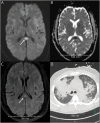Clinical Reasoning: A 47-Year-Old Man With an Upper Respiratory Infection, Acute Confusion, Dysarthria, and Ataxia
- PMID: 36697240
- PMCID: PMC10186246
- DOI: 10.1212/WNL.0000000000206864
Clinical Reasoning: A 47-Year-Old Man With an Upper Respiratory Infection, Acute Confusion, Dysarthria, and Ataxia
Abstract
A patient presenting with acute confusion, dysarthria, and appendicular ataxia with gait instability warrants a broad differential including emergent consideration of acute ischemic or hemorrhagic stroke. Moreover, in acute to subacute presentations, a wide array of etiologies including infectious causes, toxins, or autoimmune conditions may be considered. This article features a 47-year-old man who presented acutely with confusion, severe dysarthria, left upper extremity dysmetria, and unsteady gait. In this case, these neurologic signs were preceded by symptoms of an upper respiratory infection. In addition, MRI brain without contrast demonstrated a small focus of hyperintensity on diffusion-weighted imaging in the splenium of the corpus callosum with apparent diffusion coefficient match. The article illustrates a diagnostic approach in evaluating a patient with this constellation of clinical and radiologic findings, as well as pertinent management considerations. A comprehensive overview of other potential causative factors of the imaging findings is described to augment the reader's differential diagnosis. Finally, a literature review pertaining to the revealed diagnosis highlights the epidemiologic relevance and important clinical pearls.
© 2023 American Academy of Neurology.
Conflict of interest statement
The authors report no disclosures relevant to the manuscript. Go to
Figures

Similar articles
-
Clinical Reasoning: A 59-Year-Old Man With Progressive Dysarthria and Gait Instability.Neurology. 2025 Jun 24;104(12):e213729. doi: 10.1212/WNL.0000000000213729. Epub 2025 May 22. Neurology. 2025. PMID: 40403221
-
Clinical Reasoning: An 82-Year-Old Woman With Subacute Ophthalmoparesis and Ataxia.Neurology. 2023 Aug 1;101(5):e570-e575. doi: 10.1212/WNL.0000000000207246. Epub 2023 Mar 29. Neurology. 2023. PMID: 36990717 Free PMC article.
-
[A case of Marchiafava-Bignami disease demonstrated by MR diffusion-weighted image].No To Shinkei. 2000 Jul;52(7):633-7. No To Shinkei. 2000. PMID: 10934726 Japanese.
-
Neuroimaging in cerebellar ataxia in childhood: A review.J Neuroimaging. 2022 Sep;32(5):825-851. doi: 10.1111/jon.13017. Epub 2022 Jun 24. J Neuroimaging. 2022. PMID: 35749078 Review.
-
[Reversible splenial lesion of the corpus callosum on diffusion-weighted magnetic resonance imaging in hypoglycemic hemiparesis: report of two cases].No Shinkei Geka. 2009 May;37(5):473-8. No Shinkei Geka. 2009. PMID: 19432096 Review. Japanese.
References
-
- Raybould JE, Conroy ME, Timpone JG, Kumar PN. Legionnaires disease with focal neurologic deficits and a reversible lesion in the splenium of the corpus callosum. Infect Dis Clin Pract. 2017;25(1):13-18. doi:10.1097/IPC.0000000000000441. - DOI
-
- Hibino M, Hibi M, Akazawa K, Hikino K, Oe M. A case of Legionnaires' pneumonia accompanied by clinically mild encephalitis/encephalopathy with a reversible splenial lesion (MERS) with transient altered mental status and cerebellar symptoms, which responded to treatment by antibiotics and corticosteroid. Nihon Kokyuki Gakkai Zasshi. 2011;49(9):651-657. - PubMed
Publication types
MeSH terms
LinkOut - more resources
Full Text Sources
